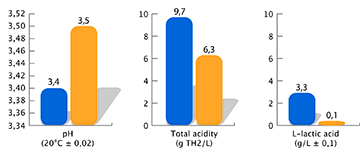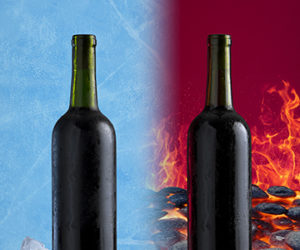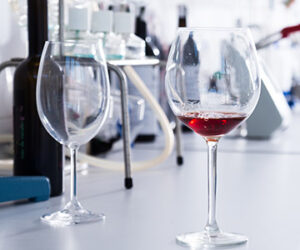
The warming climate and the rise of mean temperatures during the growth season of grapes, which has been evident in these two last decades, has caused the rise in sugar content and the decrease in acidity of musts. This has already become an issue winemakers are aware of and some are trying to compensate for, and if the trend continues in the years and decades to come, more attention will continue to be put on the matter.
There are a few different approaches professional winemakers have used to compensate for higher sugars and lower acids in grapes at harvest, and they are worth exploring and learning about for home winemakers as well.
Introduction to the Issue
Actual sugar content (glucose and fructose) in musts at maturity can easily be measured by °Brix; acidity is caused mainly by the presence in musts of tartaric acid and malic acid, commonly called titratable acidity, or TA, and expressed as tartaric acid.
Both sugar content and acidity are influenced by temperature; higher temperatures during berry maturation cause the increase of photosynthesis (and of sugar content) and the decrease of acidity, mainly due to the rapid decline in malic acid in the last phase of maturation.1
Higher sugar content in musts obviously results in an increase in wine alcohol content (% ABV, alcohol by volume). The mean yield alcohol-sugar for wine yeast is about 10 mL of ethanol produced from 16.8 g of sugar. A normal by-product of this fermentative metabolism is glycerol, which can be found in wine (2–10 g/L), and is normally considered acceptable or positive as regards sensory characteristics.
Low acidity in musts can cause several problems in winemaking: A greater activity of undesirable microorganisms, particularly bacteria, a decrease in color intensity of red wines, an increase in required sulfur dioxide doses, and possibly some negative aspects related to wine sensory characteristics.
In addition to rising temperatures, the increase in alcohol content in wines has been caused also by the trend in postponing harvest in search of more aromatic white wines and of structured red wines with more phenolic substances.
The resulting higher alcohol level and lower acidity has been particularly clear in New World wines (with an average of 13.65% ABV in 2015) rather than in Europe’s wines (13.01%).2
Approaches to Lowering alcohol content
There are several reasons in favor of lowering the alcohol content of wines:
• Health guidelines
• Concerns for driving under the effect of alcohol
• Trends in preference of consumers towards lighter wines
• Some evidence of better aromatic quality of wines with lower alcoholic content3,6
• Difficult fermentation of musts with very high sugar content
• Unbalanced wines with low acidity
So, growing wine with lower ABV has become an issue for many producers all around, for red wine in particular. Also worth noting is that white base wine for producing sparkling wine should have low alcohol content (maximum of 12%), because high ethanol levels make the second fermentation stressful and insecure.5
Some techniques to reduce alcohol levels in wine have been proposed4:
1. Adjust vineyard management in order to decrease plants’ photosynthetic activity
2. Add water to wine, when permitted by law
3. Extract ethanol excess from wine with physical technologies
4. Use microbial strategies that have the potential to alter fermentative ethanol production
This article is going to focus on the fourth option, but let’s first briefly expand on the first three.
In regards to viticultural practices to reduce sugar content of musts, aromatic and phenolic ripeness of berries in many important red varieties is normally reached late, when sugars have increased too much.2 In these cases leaf removal after fruit set can reduce the leaf area and slow down sugar accumulation, thus avoiding excess in sugar concentration.6 Another practice is simply an earlier harvest, but this can negatively impact on wine style.
Dilution of wine can have negative impacts on sensory quality as well, and is not generally looked at as a very good option.
Other easy approaches concern the cellar management during fermentation. Aeration, through open- top fermenting vats, and higher fermentation temperature can cause a decrease in alcohol level through ethanol evaporation, but aromatic substances can easily evaporate through this process as well.6
Physical removal of alcohol from wine, through advanced distillation techniques, has been proposed for commercial winemakers, but loss of other important wine compounds is frequently observed. One approach that seems to work in commercial wineries is to completely de-alcoholize a small portion of a wine lot — like one barrel — and blend that back with the other barrels (with tasting trials) to reduce overall alcohol without significantly impacting sensory characteristics. Of course, this approach is only possible in an industrial context.
Some of these approaches impact negatively on wine characteristics, or show little alcohol level reductions, which brings us to the fourth option. Microbial strategies seem more promising, because they can present the advantage of decreasing ethanol levels without compromising sensory quality.7 They are cost-effective, are possible in a home winemaking context, and have low environmental impact. So, let’s look more closely at fermentation techniques, in particular those regarding the choice of non-conventional yeasts.
Guided Fermentation
The use of starter yeast cultures to control alcoholic fermentation is a widely common technique, by which more steady fermentation is usually obtained, with less risk of sluggish yeast activity and of excess in residual sugars. The yeasts that have proved to be by far the most useful are those belonging to the genus Saccharomyces, especially for their ability to transform almost completely the must sugars, resisting high alcohol content of the fermenting wine. They normally belong to strains of S. cerevisiae and S. bayanus. Other positive traits of Saccharomyces yeasts are low release of acetic acid and other off-flavor metabolites, and resistance to medium or high levels of added sulfites. This latter trait is useful to out-compete the indigenous yeast species and strains present in musts. A lot of Saccharomyces strains have been selected by the wine industry and offered to wine producers in order to tackle several issues depending on the type of must and wine.
With the aim of managing acidity and alcohol levels, strains of S. cerevisiae were selected and isolated from natural variants; some are present in commercial formulations, featuring a lower conversion rate of sugar into alcohol. Along with the reduction of alcohol level, usually these strains show an increase in wine acidity and in glycerol content.
A new selection technique, based on osmotic pressure to select yeast cells prone to produce more glycerol, has recently been developed. By means of this technique, a new wine yeast has been proposed to winemakers that produces more total acidity, more glycerol, and less ethanol (from 0.2 to 0.8% less, depending on the potential alcohol by volume of the must). These results are due to a lower conversion rate (17.3 g sugar required to produce 10 mL ethanol). This yeast is particularly useful when fermenting a must from red grapes that are unbalanced, with too much sugar and low acidity.
There are a limited number of commercially-available yeast strains that fit this category in today’s market. Two examples include AB-Biotek Maurivin AWRI 796 and Lallemand IONYSwfTM (see Chart 1, below). Most, if not all, of these types of strains are only available in commercial-size packaging. As more research is done, however, the popularity of these strains may continue to grow and lead to their release in smaller packaging sizes specifically for home winemakers. In the meantime, if you can find some winemaking friends who want to give one of these yeasts a try, it may be worth going in on a larger amount.
Chart 1: Lallemand IONYSwfTM Fermentation Data


Non-Saccharomyces Yeasts
In the last 15 years some attention has been paid to other yeast species that can offer some positive characteristics to wine, especially the production during fermentation of pleasant aromas that are different from those released by Saccharomyces species. These non-conventional yeast species can be found, for example, in spontaneous fermentations. Also in guided fermentations, before the starter cells take over, they may contribute to the transformation of sugars to ethanol, because they are commonly found on grapes, on harvest equipment, or in the cellar environment. When they participate actively, their metabolism can add some flavor diversity to wine, an important trait in some commercial strategies. More distinctive wines, obtained through fermentation microbial techniques, can help avoid a tendency towards uniformity.2
These considerations have spurred the wine industry to launch some commercial starter cultures different from Saccharomyces species and strains. On the whole, these yeasts are called non-Saccharomyces (NS). More biodiversity during fermentation can usually be accomplished adding to must mixed cultures (co-inoculation of Saccharomyces and NS starters), or a succession of NS inoculation followed by Saccharomyces inoculation (sequential fermentation), so that the conventional yeasts can take over in the second half of fermentation. In particular, Saccharomyces strains must dominate when the crucial threshold of 5–6% ABV is reached; otherwise, there is considerable risk of stuck fermentation or of high levels of sugar residues in wine.
Respiratory Metabolism
With respect to Saccharomyces species and strains, NS strains show a larger natural variability as regards ethanol yields.7 NS strains have been tested in fermentation trials, usually coupled with Saccharomyces strains, because of their moderate reduction of ethanol production.2,3
Some NS strains show an interesting trait that increases their ability to lower wine alcohol content: The possibility of incomplete transformation of sugars into carbon dioxide, thanks to a respiratory, rather than fermentative metabolism. 2 In the first stages of alcoholic fermentation the complete transformation of sugars in carbon dioxide can result in a lowering of the alcoholic content.
Coupling these two positive features — release of agreeable by-products and respiratory (aerobic) metabolism — using NS strains is a strategy for lowering alcohol content, which in some cases, recently shown in scientific literature, has proven effective. Wine alcohol contents in these experiments have been reduced by about 1% ABV, which may be considered a
significant result.
Good results derived from the sequential inoculation of various NS species (like Metschnikowia pulcherrima, Starmerella bombicola, Hanseniaspora uvarum, Lachancea thermotolerans, Candida zemplinina, and Metschnikowia pulcherrima) plus S. cerevisiae. In experiments with these NS species the final alcohol content was reduced, in comparison to control using only Saccharomyces, by amounts variable from 0.32 to 1.64%.2 In general there has been no detection of undesirable compounds in the resulting wine. Some NS strains are commercialized, usually for co-fermentation, to obtain lower ethanol levels and new positive traits of sensory characteristics.
Some commercial examples of NS strains for winemaking include: Laffort ZYMAFLORE® ALPHA (Torulaspora delbrueckii), Lallemand LAKTIA™ (Lachancea thermotolerans), and AB-Biotek Maurivin AWRI Obsession (Metschnikowia pulcherrima).
Experiments of Oxygenation of the Must
The reduction of alcohol can be obtained without substantially changing the usual fermentation procedures in cellars, except the addition of the non-conventional yeasts prior to (or together with) Saccharomyces starters.
In other cases, some oxygenation of the must has been experimented, with the aim of favoring the respiratory metabolism of the non-conventional yeast cells, resulting in the production of CO2 rather than ethanol. Oxygenated fermentation improves the reduction of alcohol content, but can have deleterious consequences such as oxidation of some wine substances that positively contribute to sensory properties.
In the sequential fermentation with oxygenation the cells of NS (selected for respiratory metabolism) are added at the beginning, and the must is aerated; alcohol content is expected not to rise, with the production of glycerol and other metabolites; when Saccharomyces cultures are added, possibly with the addition of sulfites, the alcohol content rises normally.
It must be said that this technique is not a routine technique, but it is still at the experimental level.8 There is a debate on the first stages of the activity of NS cells: It could be a respiratory metabolism, but also a marked deviation of the fermentation metabolism towards the production of glycerol and other metabolites.
Chart 2: Lallemand LAKTIATM Microbial & Oenological Properties

Drawbacks
Some drawbacks of sequential inoculation have been highlighted:
• Release of undesirable compounds in the wine, produced by NS yeasts metabolism, such as acetic acid.2,3
• In oxygenated fermentation, destruction by oxidation of favorable compounds, such as aromatic substances.
• Necessity of lowering the doses of sulfites, because of the expected negative impact of the usual doses of sulfites on the activity of NS strains.
The interactions among NS cells, Saccharomyces cells, and other native yeast and bacteria cells are yet to be more accurately studied, aiming at avoiding competition.9
The production from NS added cells of undesirable metabolites, firstly acetic acid, should be accurately monitored during the mixed fermentation. A better control of the conditions of fermentation and of its course in the fermenting vat is crucial when these microbial techniques are adopted. Optimal concentration of sulfites should be established, depending on the species and strains involved; also, temperature, aeration, and duration of the skin extraction should be accurately monitored and their optimal values should be verified on a case-by-case basis.
Conclusion
Lower-alcohol wine is in accordance with the need of reducing alcohol-related mortality and mobility, and risks linked to high alcohol levels in blood while driving. There is also an increasing trend of consumers towards wine easier to drink and appreciate, with more subtle and complex aromatic profile.
More than agronomic or physical techniques, microbial strategies offer the potential to produce wine with acceptable lower ethanol levels, without negatively altering the expected sensory characteristics of wine. Microbial techniques look more natural and more feasible in a context of home winemaking.
One can choose specific Saccharomyces strains for their ability to reduce alcohol level, or try a more innovative approach and choose co-inoculation or sequential inoculation (NS at the beginning of the fermentation, followed by Saccharomyces). This is a more demanding and perhaps more risky option, but early trial results
are encouraging.
Non-conventional yeast formulations are already available on the market, but there are no well-defined recipes yet. Considering the ever-increasing interest worldwide for limiting the alcoholic level of wine, reliability and consistency of these microbial techniques will likely be available in the near future.
References
1 Jackson D.I., Lombard P.B. Environmental and Management Practices Affecting Grape Composition and Wine Quality – A Review. American Journal of Enology and Viticulture, vol. 44, no. 4, 1993
2 Ciani M., Morales P., Comitini F., Tronchoni J., Canonico L., Curiel J.A., Oro L., Rodrigues A.J., Gonzalez R. Non-Conventional Yeast Species for Lowering Ethanol Content of Wines. Frontiers in Microbiology, vol. 7, 2016
3 Contreras A., Hidalgo C., Henschke P.A., Chambers P.J., Curtin C., Varela C. Evaluation of Non-Saccharomyces Yeasts for the Reduction of Alcohol Content in Wine. Applied and Environmental Microbiology, vol. 80, n. 5, 2014
4 Schmitt M., Broschart S., Patz C.D., Rauhut D., Friedel M., Häge D. Application of Yeast with Reduced Alcohol Yield for Sparkling Wine Production. BIO Web Conf. Volume 12, 41st World Congress of Vine and Wine, 2019
5 Varela C., Dry P.R., Kutyna D.R., Francis I.L., Henschke P.A., Curtin C.D., Chambers P.J. Strategies for Reducing Alcohol Concentration in Wine. Australian Society of Viticulture and Oenology, 2015
6 The Australian Wine Research Institute. Reducing Alcohol Levels in Wine. Jan. 2016
7 Rossouw D., Bauer F. Microbial Strategies for Wine Ethanol Reduction. WineLand, 2017
8 Quiros M., Rojas V., Gonzalez R., Morales P. Selection of Non-Saccharomyces Yeast Strains for Reducing Alcohol Levels in Wine by Sugar Respiration. International Journal of Food Microbiology, 181, 2014
9 Du Plessis H., du Toit M., Nieuwoudt H., van der Rijst M., Kidd M., Jolly N. Mixed Culture Fermentations and Shiraz Flavour. Oenology research, Winetech Technical, 1 Aug. 2019






